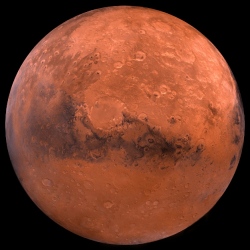
SpaceX is producing about 5 Merlin engines per week and has the factory capacity for 400 engines per year or about 8 engines per week. The Raptor engines are about the same size as the Merlin engines. The new BFR and BFS design needs 38 Raptor engines. SpaceX should be able to build about six to ten BFRs every year.
The BFR spaceships (second stage) will be reusable, Musk plans on refueling them in low Earth orbit first, and then again on the surface of Mars for their return to Earth.
They will launch several BFRs to transport and assemble a propellant plant and start to build up a base. The propellant plant would produce methane (CH4) and liquid oxygen (O2) from sub-surface water ice and atmospheric CO2.
Assuming the first BFRs are built and flying into orbit by 2023, then the first Mars mission would be in 2024.
Two robotic cargo flights, the first of which may be named Heart of Gold, are planned to be launched in 2024 to deploy a massive array of solar panels, mining equipment. They will also land as well as deliver surface vehicles like bulldozers and trucks to dig and assemble the base. There will be food and life support infrastructure.
In 2026 four more BFR landers will follow: two robotic cargo flights, and two crewed flights will be launched to setup the propellant production plant, solar arrays, landing pads, and greenhouses. Each landed mass will be at least 100 tons of usable payload, in addition to the spaceship’s dry mass of 85 tons.
The first temporary habitats will be their own crewed BFR spaceships, as they have life-support systems.
The robotic BFR cargo flights will be refueled for their return trip to Earth whenever possible.
For a sustainable base, it is proposed that the landing zone be located at less than 40° latitude for best solar power production, relatively warm temperature, and critically: it must be near a massive sub-surface water ice deposit. The quantity and purity of the water ice must be appropriate.
A preliminary study by SpaceX estimates the propellant plant is required to mine water ice and filter its impurities at a rate of 1 ton per day. The system under study is projected to produce 1 kg/day of O2/CH4 propellant while consuming 700 watts of electrical power. Overall unit conversion rate expected is one metric ton of propellant per 17 megawatt-hours energy input from solar power.
The 2026 missions would have to travel to Mars which would take a few months and they could then unload and build up the base.
